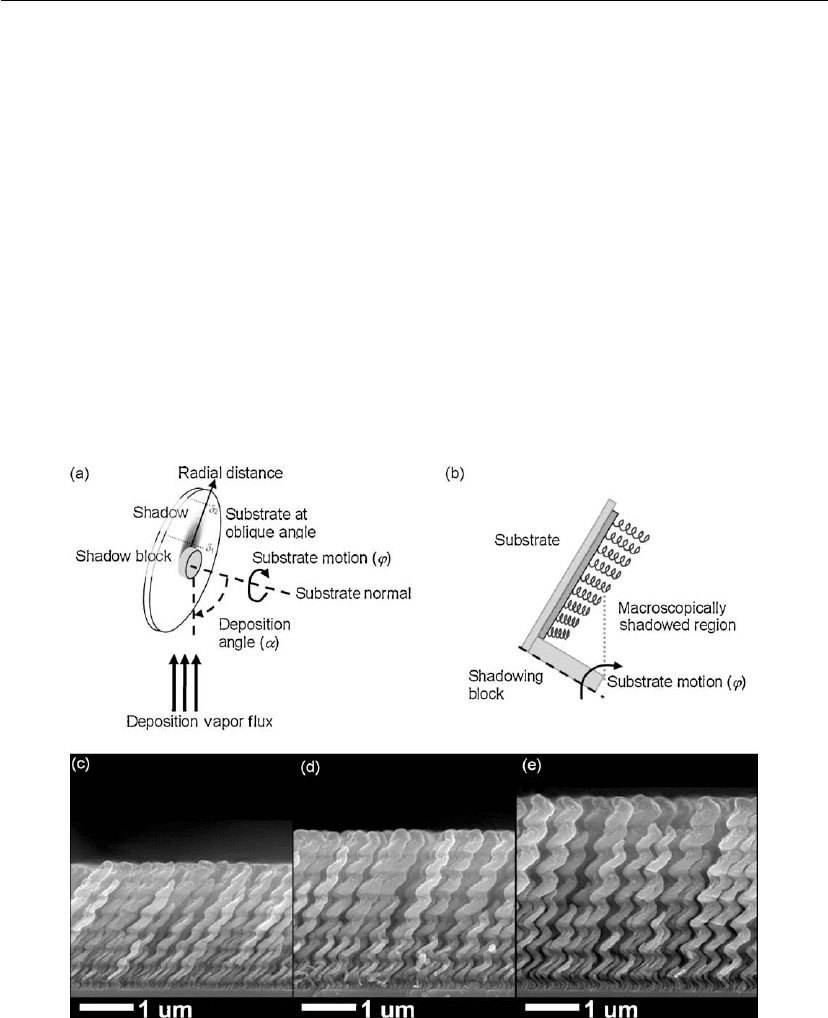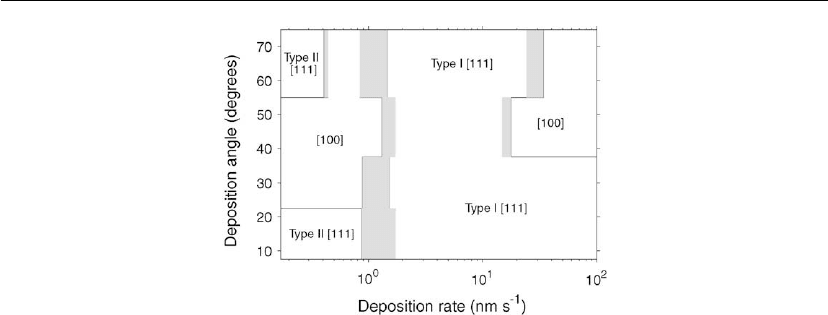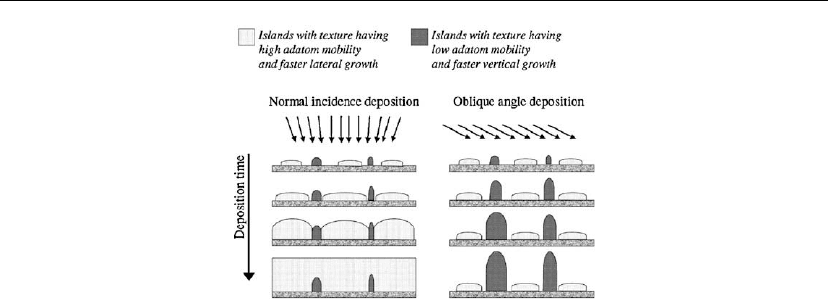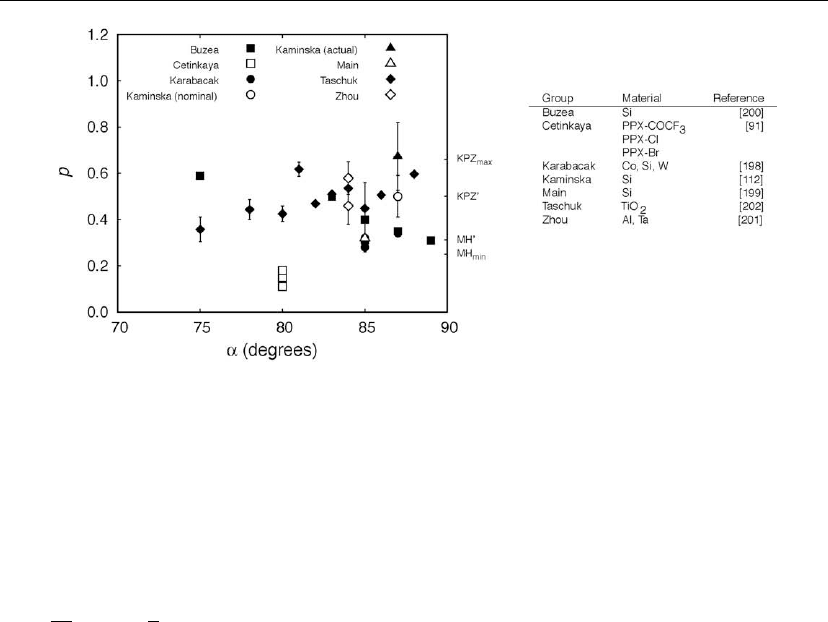Martin P.M. Handbook of Deposition Technologies for Films and Coatings, Third Edition: Science, Applications and Technology
Подождите немного. Документ загружается.


Glancing Angle Deposition 641
demonstrated in the literature is ion-assisted deposition, discussed below in Section 13.3.2.4.
Using ion-assisted depositions, a small increase in β at high α can be achieved.
13.3.2.2 GLAD Co-deposition
Co-deposition techniques have long been used for GLAD films, [146–149], and have recently
been the subject of intensive development [63, 71, 127, 135, 150–155]. Configurations that
have been demonstrated include a single material deposited from two directions [126, 146],
two materials deposited from similar directions [63, 154, 155], and two materials deposited
from different directions [135, 148].
Su et al. and He et al. have studied the optical properties of oxide films with embedded Au
[154] and Ag [63] nanoparticles, respectively. Such films exhibit interesting polarization
properties. He et al. have produced Ti-doped Mg structures, which may have application as
hydrogen storage structures [155]. Films composed of both anatase TiO
2
and monoclinic WO
3
were produced by Tesfamichael et al. for gas sensing applications [152].
Kesapragada and Gall have used GLAD co-deposition to modify the normal growth of a GLAD
column [127]. First, single crystal 1.5 m Cu columns were deposited using conventional
GLAD. Then two sources located at (α =84
◦
, φ =0
◦
) and (α =84
◦
, φ = 180
◦
) are used
simultaneously to form Y-shaped structures, with each branch oriented toward their respective
sputter source. Zhou and Gall have recently extended this work to produce columns composed
of Si and Ta, shown in Figure 13.13 [135]. The columns are split longitudinally along the axis
of the column, a morphology that may have piezo-activated or energy-scavenging
applications.
Figure 13.13: Co-deposition of Si and Ta to produce GLAD columns composed of two different
materials, split along the longitudinal axis. (Reproduced with permission from [135],
© Wiley-VCH.)

642 Chapter 13
The use of co-deposition techniques in a GLAD system may require modification to the
GLAD apparatus described in Section 13.2.3. For co-deposition methods, non-stoichiometric
evaporation or sputtering will require careful calibration. In the case of sequential depositions
with two different sources, a single vapor flux monitor is sufficient to control the GLAD
process. For high-quality structures produced using two or more sources, independent,
simultaneous measurements of each source will be required. In this case, individual vapor flux
monitors must be shielded such that only one source contributes to each monitor.
13.3.2.3 Substrate Temperature Control
One of the key conditions of the GLAD deposition process is that surface diffusion is
insufficient to allow adatoms to fill in ballistic shadows. During deposition, the substrate will
heat through two mechanisms: direct radiative heating from the vapor source, and heating
from vapor condensation on the substrate. Adatom diffusion length increases with
temperature, so the effectiveness of ballistic shadowing decreases with temperature as adatoms
diffuse further. Direct control of substrate temperature for GLAD has been studied by several
groups [49, 69, 156–158]. GLAD depositions of Pd [69],Co[49], and TiO
2
[157] at cryogenic
substrate temperatures have been reported.
A general degradation of GLAD helical structure quality has been reported by Schubert et al.,
who deposited Si spirals at substrate temperatures up to 475
◦
C [156]. Work by the same
group, reported by Patzig and Rauschenbach [158], has shown that a single GLAD column can
evolve through several of the classic GLAD structures: spirals, screws, and vertical posts, with
carefully selected deposition conditions. Similar observations were reported by Robbie et al.
for an S:O column [159].
The combination of material, deposition rate, substrate rotation rate (or algorithm), and
substrate temperature together define a morphological phase space which will control the
precise column morphologies produced during a GLAD deposition. The experiments reported
by Robbie et al. [159] and Patzig and Rauschenbach [158] can be thought of as tracing a route
through this space. There is a vast parameter space available for GLAD depositions, and only
in isolated cases is the dependence of column structure on deposition parameters well
understood. The careful experiments needed to understand these effects have begun, but
much work remains. Another aspect of these issues, column crystallinity, is discussed in
Section 13.4.1.1.
13.3.2.4 Other Advanced Methods
Ion-assisted GLAD
Ion-assisted GLAD has been studied by a few groups [50, 160–162]. The use of low-energy
ion bombardment during GLAD deposition has been shown to increase β in slanted
posts when the incident angle of the ion beam is less than the vapor flux deposition angle α

Glancing Angle Deposition 643
[50, 161]. This is likely due to resputtering of column top surfaces, leading to redeposition on
the bottom surface of adjacent columns. Hodgkinson and Wu [50] and Fleischauer et al. [161]
studied this effect for optical applications. Kitagawa et al. have optimized deposition angle for
a scalable ion-assisted GLAD process to produce smooth diamond-like coatings [160].
Taschuk et al. have used ion-assisted GLAD to modify the density of vertical post films in an
effort to improve the responsivity of relative humidity sensors [162].
External shadowing
Krause and Brett developed a modification to the GLAD technique, imposing an additional,
macroscopic shadowing element which modifies GLAD depositions [163]. Their set-up and
images of the resulting films are given in Figure 13.14. The addition of a cylinder at the center
of a deposition chuck produces a region shadowed from incoming vapor flux. As a substrate
rotates through this region, it experiences a periodic, momentary reduction in vapor flux which
modifies GLAD structures. The response of helical thin films to such shadowing is seen in
Figure 13.14(c–e).
Figure 13.14: Shadowed GLAD method: (a) A shadow block placed in the center of the obliquely
inclined substrate casts a shadow, resulting in (b) a graded thin film with structure defined by
substrate motion. SEM images of α =85
helices located (c) 1 mm, (d) 13 mm, and (e) 56 mm
from shadow block edge. (Reproduced with permission from [163], © Wiley-VCH.)

644 Chapter 13
Sequential GLAD
A simple way to combine the properties of different materials within a single GLAD film is to
deposit different materials sequentially; a few recent examples are discussed here. A GLAD
structure is grown with one material, followed by an additional deposition with a different
material [153, 164–166]. This method is distinct from co-deposition, where two vapor sources
are used simultaneously. Alouach et al. have deposited a GLAD Cu layer as seeds for
Permalloy (Ni
80
Fe
20
) nanowire arrays [165]. Anisotropic Ag nanoparticles have been
deposited on SBD SiO
2
posts for surface-enhanced Raman applications [166]. Photocatalytic
properties of TiO
2
have been enhanced using WO
3
support structures [153].
13.3.3 Postdeposition Treatments
The structures available to GLAD are robust enough to survive several treatments, including
annealing, etching, oxidization, chemical functionalization, and templating processes. In this
section, postdeposition processing of GLAD thin films is discussed.
13.3.3.1 Annealing
Postdeposition annealing of GLAD structures is one method for achieving a crystalline,
nanostructured thin film. The impact of annealing of GLAD thin films has been studied by
many groups [15, 57, 60, 61, 69, 156, 157, 167–173]. Film morphologies have been widely
observed to survive the annealing process [57, 156, 167, 171], although a reduction in surface
area [69, 157] and thickness [61, 170] has been reported for some materials. One common
application of annealing has been to activate photoluminescent materials such as Y
2
O
3
:Eu
[60, 61, 169], ZnO [15], and Si through production of Si nanocrystals [174, 175]. Such
annealing processes correct stoichiometric or crystallinity deficiencies in the as-deposited
material, greatly improving the photoluminescent efficiency.
Another application of postdeposition annealing has been the blueshift of the wavelength of a
circular Bragg peak [170]. In that work, Pursel et al. cite a combination of competing effects: a
blueshift due to column thinning and a small reduction in circular pitch, and a redshift from
TiO
2
transition (amorphous to anatase). Such competing effects complicate the use of
annealing processes for GLAD films, but ellipsometric measurements can address the relative
magnitude of these effects, allowing good design choices.
13.3.3.2 Density Modification: Etching and Oxidization
Although GLAD structures can take many forms, film density can be constrained. In such
cases, it is possible to modify density postdeposition through etching processes which remove
material [133, 176, 177], or oxidization processes which add material [178, 179]. Etching
processes for GLAD thin films were first investigated in detail by Lakhtakia and Horn for
tuning of optical filters [176]. Subsequent work by the same group demonstrated this effect

Glancing Angle Deposition 645
experimentally with TiO
2
spectral hole filters [177]. In this work, Pursel et al. demonstrated a
25 nm blueshift in the wavelength of a spectral hole filter for an 80 minute etch. The leisurely
rate of change suggests that precise adjustments to optical properties can be made.
Another method to modify GLAD film density while retaining the columnar structure is to
oxidize the film. This approach has been explored for optical applications by Robbie et al.
[178] and Summers and Brett [179]. Robbie et al. oxidized Si rugate optical filters, converting
them to silica. This procedure enhances the filter’s visible band transmission and reduces its
average optical index. Summers and Brett oxidized Si square spirals in an effort to increase the
structure’s fill factor for photonic crystal applications [179]. This approach combines the
high-quality structure produced by GLAD with a higher density than is usually attainable by
direct deposition. Using these density modification techniques, a desired β can be achieved,
without necessarily accepting the density produced by GLAD.
13.3.3.3 Chemical Functionalization
Owing to the wide selection of materials available to GLAD, it is possible to produce films
that are amenable to chemical functionalization [82, 134, 180–184]. Tsoi et al. have
demonstrated that GLAD structures can survive functionalization processes, and that the entire
film is likely affected [180, 182]. In this work, siloxane-based functionalization was chosen for
flexibility and durability of the resulting coatings [180]. Such work expands the available
surface chemistry for GLAD films, which has applications in sensors and other devices. It is
also possible to adjust the hydrophilicity of TiO
2
through ultraviolet irradiation. Taschuk et al.
have exploited this effect, along with the photocatalytic nature of TiO
2
, to develop an
anti-aging procedure for relative humidity sensors [185]. The easily accessible, high surface
area films produced by GLAD make excellent platforms for chemical functionalization
treatments. Some applications for such treatments are discussed in Section 13.5.2.
13.3.3.4 GLAD Templating
Some materials, such as low-melting-point metals or complex organics, are difficult or
impossible to deposit directly in a GLAD film. In cases where the properties of such materials
must be combined with the geometric properties of a GLAD film, templating methods can be
used [96, 99, 101, 103, 186]. Harris et al. developed the templating method [103] shown in
Figure 13.15.
The template process begins with a GLAD film (Figure 13.15a), which is filled with an
intermediate material such as photoresist (Figure 13.15b). The choice of intermediate material
is important, since it must be orthogonally etchable with the template material. The
intermediate material is etched to expose the top of the original GLAD film (Figure 13.15c),
which is subsequently etched to produce a perforated thin film composed of the intermediate
material (Figure 13.15d). Au, Ni, and polystyrene perforated thin films were produced by
Elias et al. using a similar method [101].

646 Chapter 13
Figure 13.15: GLAD templating begins with (a) a standard GLAD film, which is (b) filled with an
intermediate material such as photoresist. The photoresist is (c) etched to expose the tops of the
original GLAD film, which is (d) then etched to produce a perforated thin film retaining the GLAD
geometry. (Reproduced with permission from [103], © 2001, The Electrochemical Society.)
Harris et al. produced Cu and Ni GLAD copies of a SiO
2
GLAD film through a
double-templating process [99]. A template is first produced using the above process, followed
by electrodeposition through the perforated thin film to achieve a copy. This work was
extended to organic materials by Elias et al., although vacuum filling was necessary to
infiltrate the various acrylates into the perforated thin film template [96].
Summers has developed a low-pressure chemical vapor deposition (LPCVD) process for
production of inverse square spirals [110], a photonic crystal structure discussed further in
Section 13.5.1.1 (Photonic crystals).
13.4 Proper ties of GLAD Thin Films
This section discusses the properties of GLAD thin films at several different length scales.
Below ≈100 nm, properties related to a single column dominate. Such properties include
crystallinity, width and magnetic anisotropies. Between ≈ 100 nm and ≈ 1 m, an ensemble
of columns control properties such as surface area and electrical conductivity. Above 1 m, the
‘bulk’ properties of the overall film control thermal and optical properties. GLAD’s ability to
partially decouple the different length scales in thin film fabrication makes it possible to
produce materials with interesting and useful properties.
13.4.1 Column Properties
13.4.1.1 Crystallinity
Since GLAD is a low-temperature process (T
substrate
∼≤0.3 T
melting
), one does not expect a
thin film with long range crystalline order to be produced during deposition. However, owing
to the small size of individual GLAD columns, adatom mobility can be sufficient to produce
single-crystal columns during deposition. Such columns have been produced for a wide range
of materials: Al [30],Co[115], CrN [187],Cu[125, 126],Ge[54, 55],Mg[62],Sn[188],
Ti-doped Mg [63],Ru[76], β-phase W [90, 189], and ZnO [190]. Crystalline organic GLAD

Glancing Angle Deposition 647
Figure 13.16: Okamoto et al. phase diagram for Fe thin film texture as a function of deposition
rate and angle. Shaded regions are mixtures of phases in the horizontal direction. (Adapted from
[26].)
films have also been produced for C
60
and pentacene [83]; partially crystalline films composed
of PPX derivatives have recently been reported [91]. No catalyst was required to achieve
single-crystal nanorods, unlike conventional vapor–liquid–solid techniques.
Van der Drift identifies three principal factors which may introduce texture in a thin film:
preferentially oriented nucleation, evolutionary or competitive selection of initially random
nucleation, and postdeposition crystallization [191]. Annealing of GLAD films is discussed in
Section 13.3.3; here we discuss texture formation during GLAD processes. Since different
crystal faces grow at different rates, the vertical growth rate of a crystal is sensitive to its
orientation. Assuming randomly oriented crystallites at the substrate, the orientation with the
greatest vertical growth rate will be the most likely to survive and emerge as the dominant
texture in the film. Because of its competitive nature, this principle is reminiscent of the
competitive growth process found in GLAD.
Conditions under which GLAD columns become textured have been reported by many groups
[25, 26, 49, 54, 55, 59, 90]. Okamoto et al. have been studying oblique deposition of Fe thin
films for many years [25, 26, 59], culminating in a detailed mapping of Fe crystallinity as a
function of deposition angle and deposition rate, as shown in Figure 13.16. Similar studies for
Co [49] and Ge [54, 55] have been performed.
Karabacak et al. have studied single-crystal β-W formation [90]. A schematic for Karabacak’s
model is given in Figure 13.17. During initial growth, a mixture of α-W and β-W islands form
on the substrate. However, the β-W islands are favored in GLAD growth since they have lower
adatom mobilities and act as diffusion sinks for deposited adatoms. Once the β-W islands start
collecting more adatoms, they will grow faster and thus tend to capture more incoming vapor
flux, reinforcing the faster growth.

648 Chapter 13
Figure 13.17: Karabacak’s model for texture formation in β-W GLAD thin films. During initial
nucleation, a mixture of phases is produced. Differential adatom mobility causes the β-W regions
(dark gray) to act as diffusion sinks for adatoms. At oblique deposition angles, the enhanced
growth rate of β-W regions is enhanced by geometric shadowing. (Reprinted with permission
from [90], © 2003 American Institute of Physics.)
The relationship between column growth direction and crystallinity has been studied for
several materials [24, 76, 192–197]. A preferential crystalline orientation is observed in many
cases, but no general trend exists. Hagemeyer et al. have studied the deposition of Co–Cr
magnetic thin films for a variety of substrates and deposition conditions for a fixed α of 45
◦
[24]. Hagemeyer et al. note that the c axes of their films were always oriented along the
column growth direction. However, Moon and Shin report that the 111 axes of Co-Pt films
were not aligned with column growth direction [192]. The situation becomes more complicated
for the case of rotating substrates [76, 193, 194]. Yamaguchi et al. observed an optimum
rotation rate for producing crystalline YSZ layers by GLAD [193]. Alouach and Mankey have
found a dependence of Cu crystal orientation on α and substrate rotation rate [194]. Similar
results were obtained for Ru columns by Morrow et al. [76]. One final avenue of control
is the expected dependence of film crystallinity on substrate material and crystallinity
[24, 195].
Grain boundaries can influence column morphology during growth. Wang et al. have
demonstrated that stacking faults can cause bifurcation in Cu vertical post films [125].
Through a combination of molecular dynamics simulations and experimental investigations,
they were able to attribute the formation of Y-shaped columns to the interaction of stacking
faults and a large diffusion barrier between different facets of the Cu crystal. By manipulating
the deposition conditions, it may be possible to control this branching and use it to fabricate
more complicated nanostructures.
Nanocrystallites have been observed within and on GLAD columns [119, 154, 171, 174, 175].
Indutnyy et al. have produced Si nanocrystals within SiO
2
columns by annealing SiO
2
films at

Glancing Angle Deposition 649
700
◦
C and 950
◦
C, followed by radio-frequency (RF) plasma passivation in a mixed H
2
/N
2
atmosphere [174]. Photoluminescence from the Si nanocrystals was observed in the original
report, and studied further as a function of several chemical treatments [175]. Summers et al.
[119] and Schubert et al. [156] have observed the presence of similar nanocrystals, though
photoluminescence was not investigated. Using a co-sputtering GLAD technique, amorphous
SiO
2
columns with Au nanocrystals have been produced by Su et al. [154].
The empirical studies discussed here are ahead of theoretical or modeling efforts in this area.
While some molecular dynamics work, such as that performed by Wang et al., is offering
useful insights into the underlying physics governing GLAD columns, in general the size of
physically interesting domains renders molecular dynamics simulations intractable. One
avenue for development of this area is to make further use of the literature on magnetic
materials deposited by oblique angle sputtering techniques. While the magnetic work is
typically confined to α ≤60
◦
and stationary substrates, it does offer some useful insight into
GLAD processes.
In general, the impact of crystallinity on a particular material in a GLAD film must be
evaluated on a case by case basis. While it may not be possible to control crystallinity or
texture in all cases, the dependence of crystallinity on deposition angle reported by Alouach
et al. and Morrow et al. suggests that the GLAD technique might offer an opportunity to
control thin film crystallinity in an interesting manner. One of the common characteristics of
the work presented in this section is the relatively high rotation rates: 30 rpm or higher. This
may have the effect of isolating adatoms on the surface, such that crystal–adatom interactions
would dominate column growth. While much work remains to be done in this area, the wide
range of behaviors observed to date indicates that this is a promising area.
13.4.1.2 Column Width
Vertical post films are deposited at oblique incidence with a constant substrate rotation.
Column diameter of vertical post films has been studied as a function of deposition angle and
film height by many groups [91, 112, 198–202]. Column diameter is described using a power
law:
w
(
t, α
)
∝ t
p(α)
(13.9)
where w is column width, t is film thickness, and p is a characteristic growth coefficient which
depends on deposition angle α. Literature results for several materials are given in Figure
13.18. This work started with Karabacak et al., who derived theoretical limits for p based on
interface growth models [198]. Such models exhibit two characteristic growth coefficients,
describing growth parallel and perpendicular to the substrate plane projection of the incoming
vapor flux. Karabacak et al. extended results applicable to the case of stationary substrates to
the GLAD case by taking a geometric average of the growth coefficients. A limited range for p

650 Chapter 13
Figure 13.18: Literature values for p from the column growth model described in the text. The
theoretical limits for p for shadowing dominated (KPZ limit, 0.5) and diffusion dominated growth
(MH limit, 0.3) are given on the right side of the plot. Both limits are violated by experimental
data points. Experimental data are described in the table. Several data points and error bars are
not visible due to overlap with other results.
was obtained:
5
16
≤ p ≤
1
2
(13.10)
The upper limit corresponds to shadowing dominated growth, imposed by the
Kardar–Parisi–Zhang (KPZ) model. The lower limit corresponds to growth with shadowing
and diffusion, imposed by the Mullins–Herring (MH) model. The interface models are well
described by Barab
´
asi and Stanley [203]. Experimental values for p are given in Figure 13.18.
The limits derived by Karabacak et al. are shown on the right side of the plot, denoted by
KPZ
and MH
. The minimum and maximum values for the stationary cases (MH
min
and
KPZ
max
) are also given.
The data in Figure 13.18 show that no consensus has yet emerged for literature values. The
data given here are for many materials, listed in the table inset in Figure 13.18. While the data
from Karabacak et al. and Cetinkaya et al. suggests that p varies with material, it is clear from
the Buzea and Taschuk data that significant scatter exists even for a single material. This
scatter is also observed between different groups, as seen by the scatter for Si columns at an α
of 85
◦
. As a result, the variation in p as a function of material reported by Karabacak and
Cetinkaya may not be statistically significant.
More serious is the violation of the theoretical limits proposed by Karabacak et al. While most
data are within the range given by Eq. (13.10), data from multiple groups are outside.
